IN THE SUPERIOR COURT OF THE STATE OF WASHINGTON FOR KING COUNTY
Wills et al, V. Seattle Children's Hospital,
19-2-31648-9 SEA ORDER ON MOTION FOR CLASS CERTIFICATION
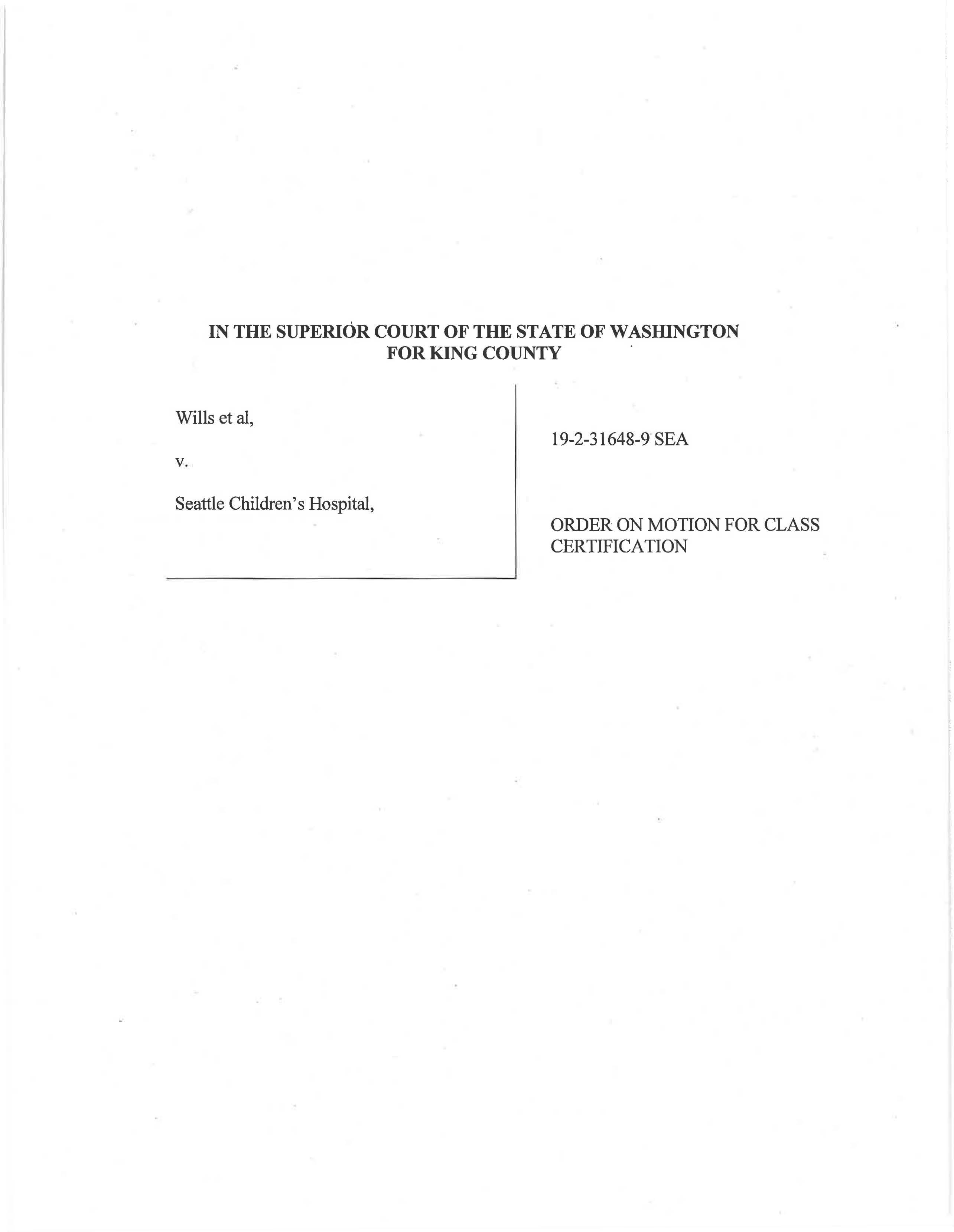
Factu a l Ba c k ground
The Plaintiffs move for class action certification for two classes under claims of medical negligence, premises liability and informed consent related to the exposure of patients at Seattle Children's Hospital (SCH) to the aspergillus fungus. The parties submitted factual materials as well as Plaintiffs' Sixth Amended Complaint (SAC).

Aspergillus is a mold and fungus that is present everywhere, but in a sufficient concentration it can pose serious injuries or even death. The patient's physical health plays a role in the seriousness of the exposure, and of course, patients at SCH are sick or injured. For this motion specifically, there are factual allegations and evidence that during the time period December 2, 2016 to 2019, patients became potentially exposed and some became sickened and injured by aspergillus in its hospital facilities at 4800 Sandpoint Way. See SAC, para. 2.49; p. 60, 6.186-.187. The air handling units (HVAC) were the main source of the spread to operating rooms and other areas. Zerr Deel, paras 3- 7. Plaintiffs allege that SCH knew of the problems for years and failed to disclose these material facts to patients.
SCH twice sent formal notices to patients of possible exposure in certain parts of the hospital. The notices were sent in 2018 (136 patients) and 2019 (approximately 3,000 patients). Para. 2 &3 Deel of Morray; Deel of Koehler, Ex. 5. SCH states that there were no families that responded with a complaint or grievance in response to any of these notices, Morray Deel at para 4. Parents and patients fllso h<we learned about the exposure in a variety of other ways, including the Seattle Times, television news, their pediatricians and even neighbors.
I I 1 ' " '.2 C
Hon. Jim Rogers
King County Superior Court Dept. 45 516 3 rd Avenue KCC-SC-0203 Seattle, Washington 98104
SCH contacted patients it deemed to be high risk from surgical site infections in 2019 and offered free anti-fungal prophylaxis treatment. Zerr Deel para 8. Eighty-seven chose to take it. These patients were prescribed different medications and have different underlying conditions. Morray Deel. para 5 & 6; Herd Deel, Ex 4 (under seal, Docket 502).
Patients can suffer side effects from these medications. Desai Deel. para 13-21. In addition, the treatment itself may have serious interactions with other drugs that a patient may be taking already for the very reason they entered ~CH. Id. The list of possible side effects to Voriconazole and Posaconazole are quite extensive. Id.
SCH reported that 39.5% of all patients they provided the prophylactic medications had side effects. Dr. Desai Deel, para 17; Herd Deel, Ex 4 (under seal, Docket 502). The cause of the side effects can be difficult to determine because some patients are on multiple drugs with various underlying conditions. Deel of Dr. Zerr, para 8. Patients' treatment for their underlying health condition must sometimes be modified. Desai Deel.
Discussion and Conclusions
On January 14, 4022, the Hon. Dean Lum denied a motion for class certification in this case, specifically denying class certification for a class under CR 23(b )(2) with prejudice and denying certification of the proposed class under CR 23(b)(3) with prejudice. Docket 413. See also Docket 410 on partial summary judgement.
However, Judge Lum allowed plaintiffs to "move to certify a narrower class under CR 23(b)(3) that is not overbroad and does not implicate individualized case specific inquiry, 21 l l !l t:
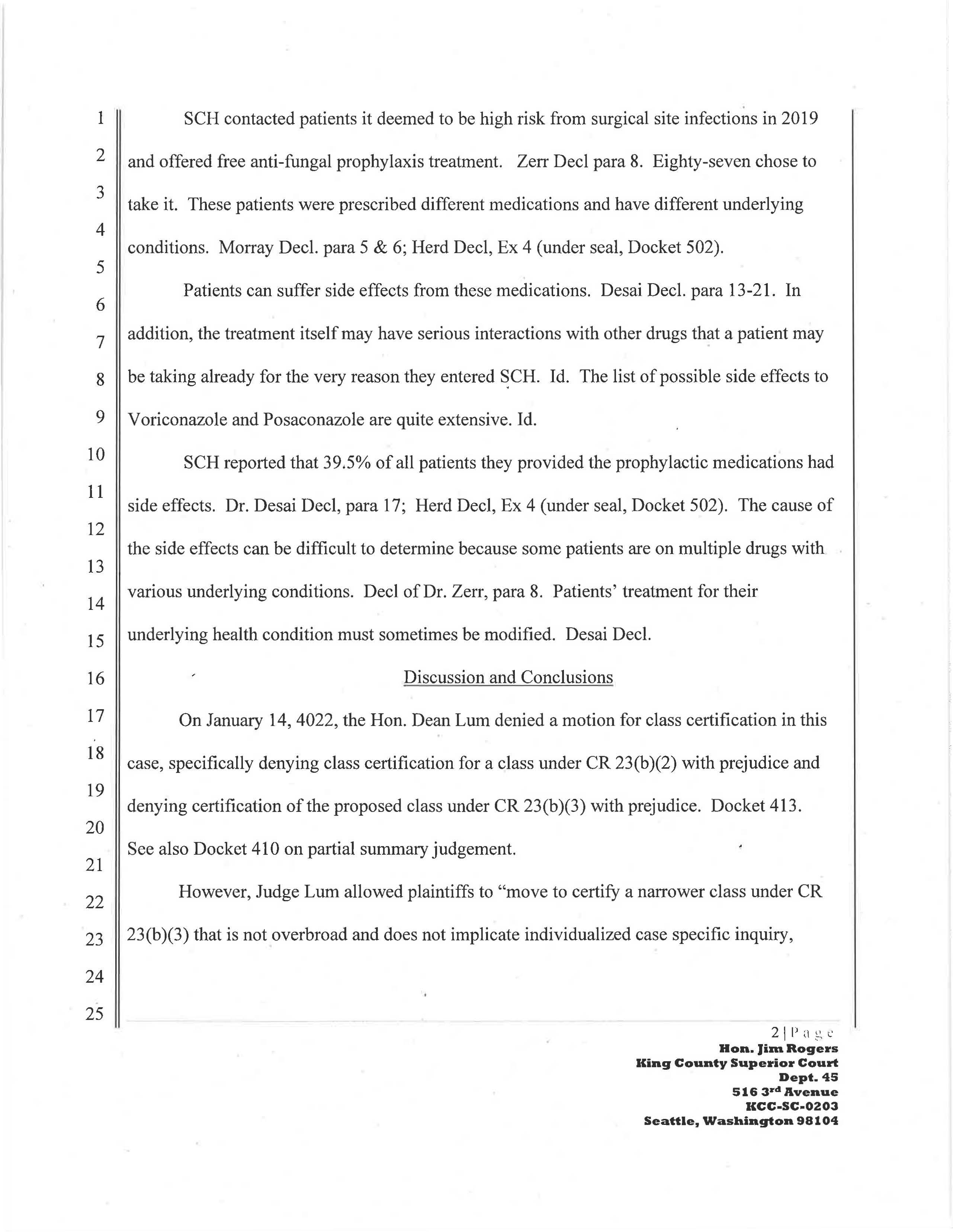
Hon. Jim Rogers
King County Superior Court Dept. 45 516 3 rd Avenue KCC-SC-0203 Seattle, Washington 98104
understanding that a narrower class logically runs into numerosity issues and that the plaintiffs' premises liability claims are inherently case specific."
In this motion, the plaintiffs seek to certify two classes under CR 23(b)(3). The proposed Notice Class is defined as
All of Defendant's child patients and their parents, who received notice of potential Aspergillus exposure at Seattle Children's Hospital between December 2 2016 and the Present, and suffered special and/or general damages as a result of the notice and /or potential exposure to Aspergillus.
The proposed Prophylaxis Class is defined as
All Defendant's child patients and their parents where the children were treated prophylactically for Aspergillus due to exposure on Defendant's premises between December 2, 2016 and the Present, and suffered special and/or general damages as a result.
Analysis
of the proposed Notic lass
The class is defined as those who were damaged as a result of receiving notice and/or as a result of potential exposure to aspergillus. At argument, plaintiffs' counsel clarified that the class was for those who received notice that they had been exposed to aspergillus and would include damages for potential exposure, although damages solely for notice was a possible claim.
Plaintiffs must prove all four elements of CR 23(a) as well as the elements of (b)(3).
CR 23(a)(l) Numerosity: Plaintiffs claim 3,600 potential class members. In the earlier proposed class, one of the prohlems that led the Court was that individual fact finding would be required to determine membership in the class. The Notice Class has the same flaw. The Class is defined as those who suffered damages as a result of receiving the notice. Thus,
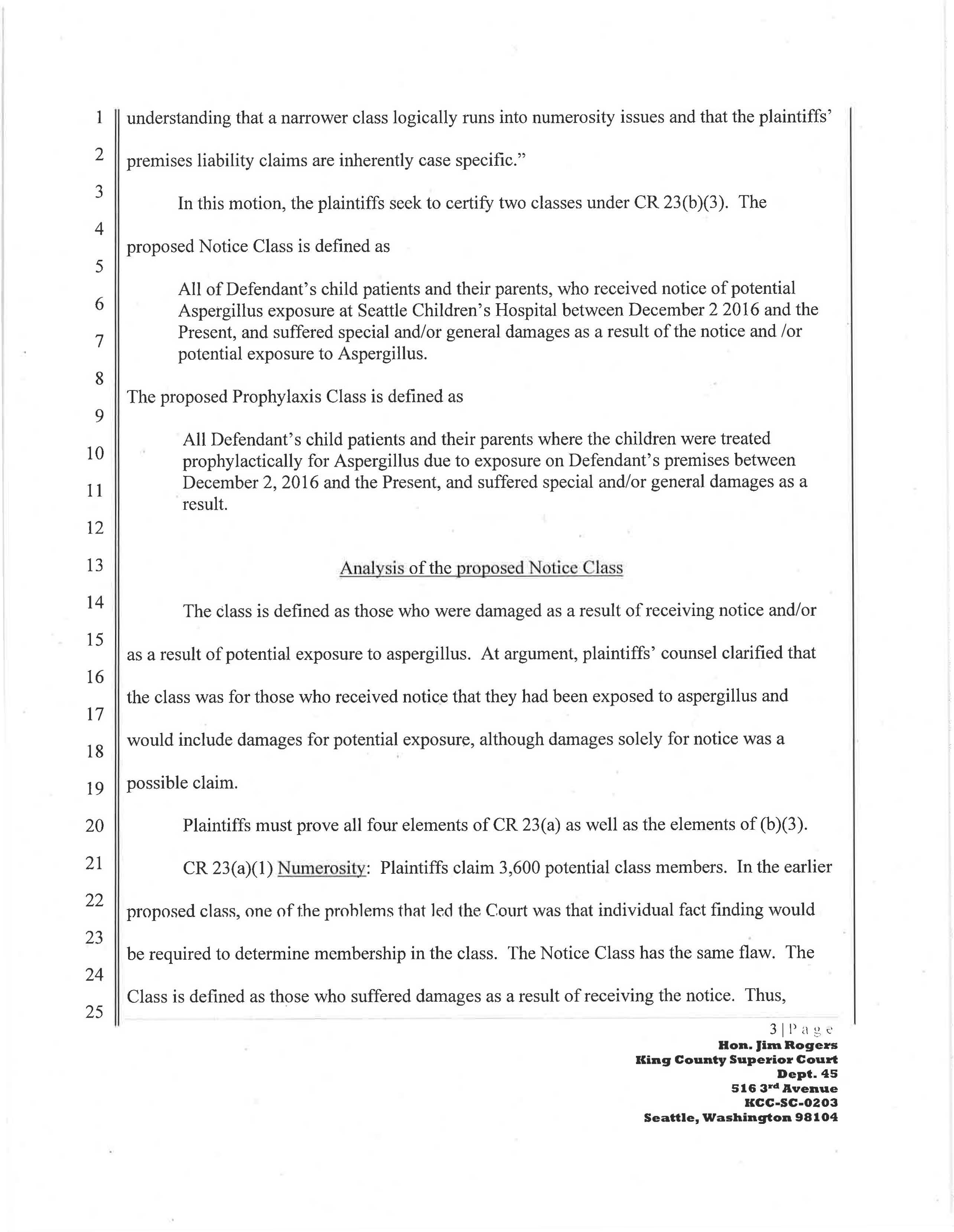
3 I I) ii g ~·
Hon. Jim Rogers
ICing County Superior Court Dept. 45 516 3 rd Avenue KCC-SC-0203 Seattle, Washington 98104
evidence of damage is necessary to even determine membership in the class. This court would not be able to determine numerosity and know who belonged to the class until the trial for damages was over for all litigants. This renders the class definition inadequate. See Cashatt v. Ford Motor Company , 2022 WL 1987077, *4.
Moreover, the term "notice" means a wide variety of factual circumstances in this case, including notices from SCH, neighbors, pediatricians and the Seattle Times In other words, what was "notice" was different for different people, explained differently with different impacts. For this additional reason, the class is not ascertainable.
CR 23 (a)(2) ommonali ty . Plaintiffs must prove that a class action has the capacity to generate common answers to common questions. Wal-Mart Stores Inc, v. Dukes, 564 U.S. 338, 350 (2011). The proposed questions are on pages 15-16 of Plaintiffs' brief. The damages questions are not common. Plaintiffs argue that proximate cause and damages are the same for everyone-treatment and follow-up. Their own expert provides evidence to the contrary. Dr. Desai testifies that side effects are common, and in the prophylaxis group it ran to nearly forty percent. As noted in Judge Lum's earlier Order of January 18, 2022, the patients who may have been exposed at Seattle Childrens were there "for a wide variety ofreasons, receiving a wide variety of treatment." Order p.4. The record includes evidence that the treatment for infection may interfere with existing medical treatment. Then there is the issue of damages related solely from the receipt of the notice. There is some evidence in the record that many notified were not damaged at all by receiving
41 p ,1 g,; Hon. Jim Rogers l<ing County Superior Court Dept. 45 516 3 rd avenue KCC-SC-0203 Seattle, Washington 98104
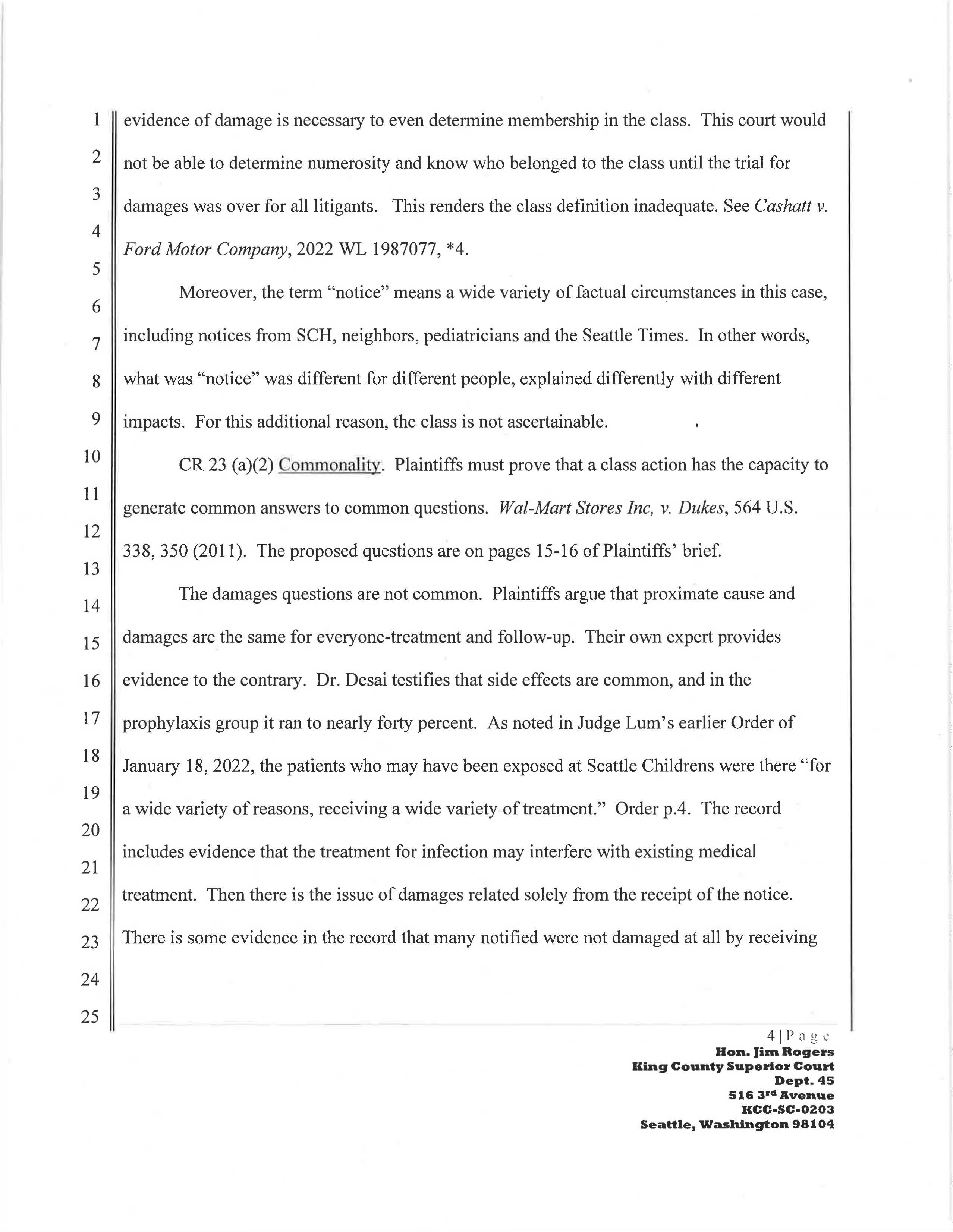
the notice The proposed common questions will not generate common answers on damages and cause.
The determination of damages and determination of membership in the class is bound together. This class fails the test of commonality.
CR 23 (a)(3)-(4) Typi ality and Adequacy The Court did not reach the issue of typicality or adequacy of the proposed class representatives under CR 23(a). 23(b)(3) Predominance a nd Sup e riority. CR 23(b)(3) requires a party to satisfy the four requirements of CR 23(a) and show that "questions oflaw or fact common to the members of the class predominate over any questions affecting only individual members" (predominance) and that " a class action is superior to other available methods for the fair and efficient adjudication of the controversy" (superiority). The predominance demand is stricter than Rule 23(a)(2)'s commonality requirement: it is not just that common issues exist , the predominance inquiry determines the further question of whether these are more prevalent than non-common issues See McLaughlin on Class Actions , sec. 5.23.
Of the four factors for CR 23(b)(3), the fourth is most determinative. This Court has found that there are not common issues and that membership in the class cannot be determined without a trial on damages. The Plaintiffs have not demonstrated how damages could be proven on a class wide basis, with varying reactions to notice, various exposures to aspergillus , various reactions to prophylaxis-all of which need to be shown just to be a member of the class. s 111 ,1 e
Hon. Jim Rogers King County Superior Court Dept.45 516 3 rd Avenue
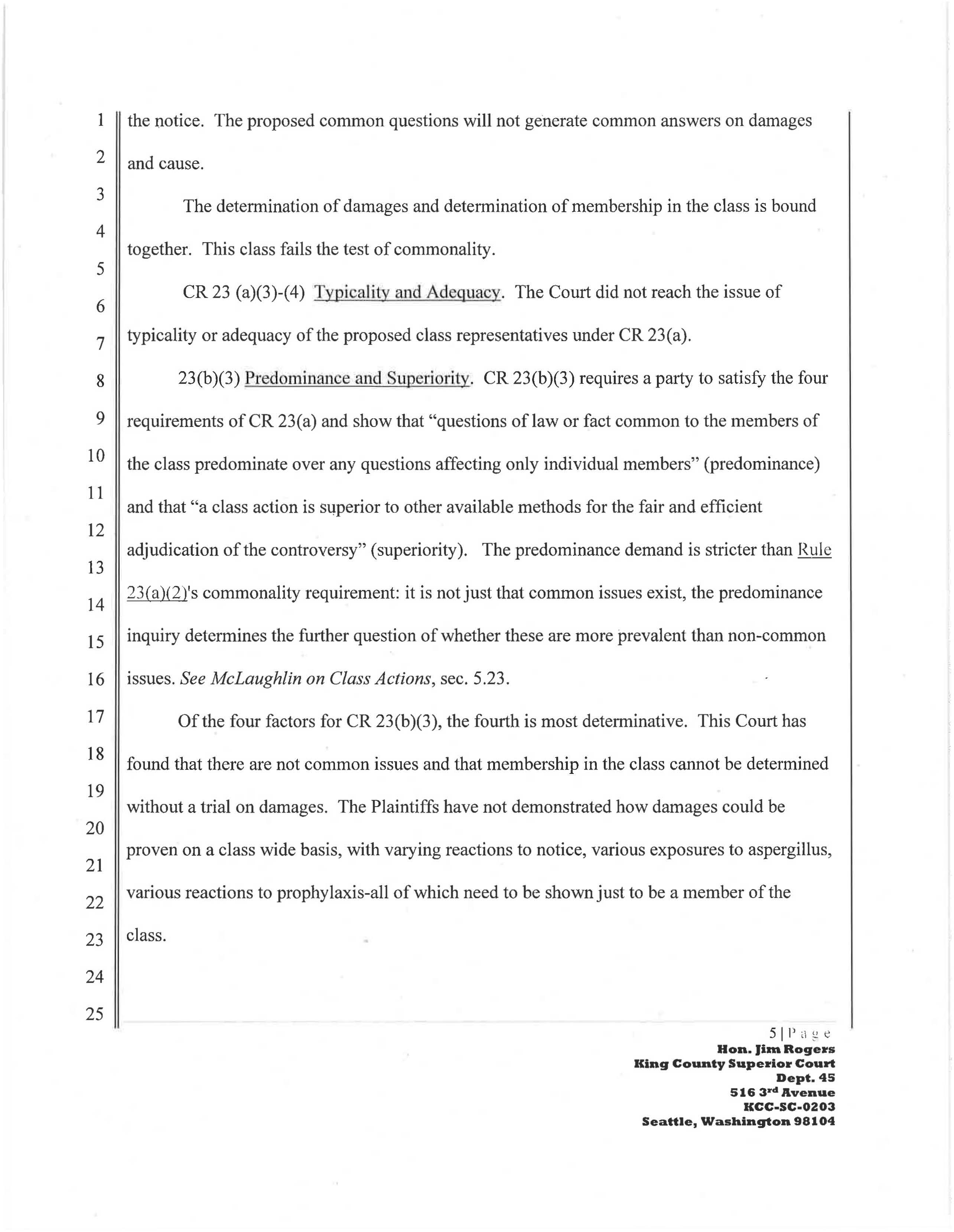
The vehicle of class action is not superior as it would require individual fact finding for prospective members. The common issues do not predominate for this proposed class.
For these reasons, the Court Denies the class certification of the proposed Notice Class under CR 23(b )(3) with prejudice.
All Defendant's child patients and their parents where the children were treated prophylactically for Aspergillus due to exposure on Defendant's premises between December 2, 2016 and the Present, and suffered special and/or general damages as a' result.
As a preliminary matter, this Court exercised its discretion to alter this definition in an attempt to certify the class. The presented evidence and allegations in the SAC did not support parts of the proposed class definition. The presented evidence and allegations in the SAC was for the time period December 2, 2016 to 2019, at the hospital premises, and concerned patients. Here is the definition of the proposed class that Court considered:
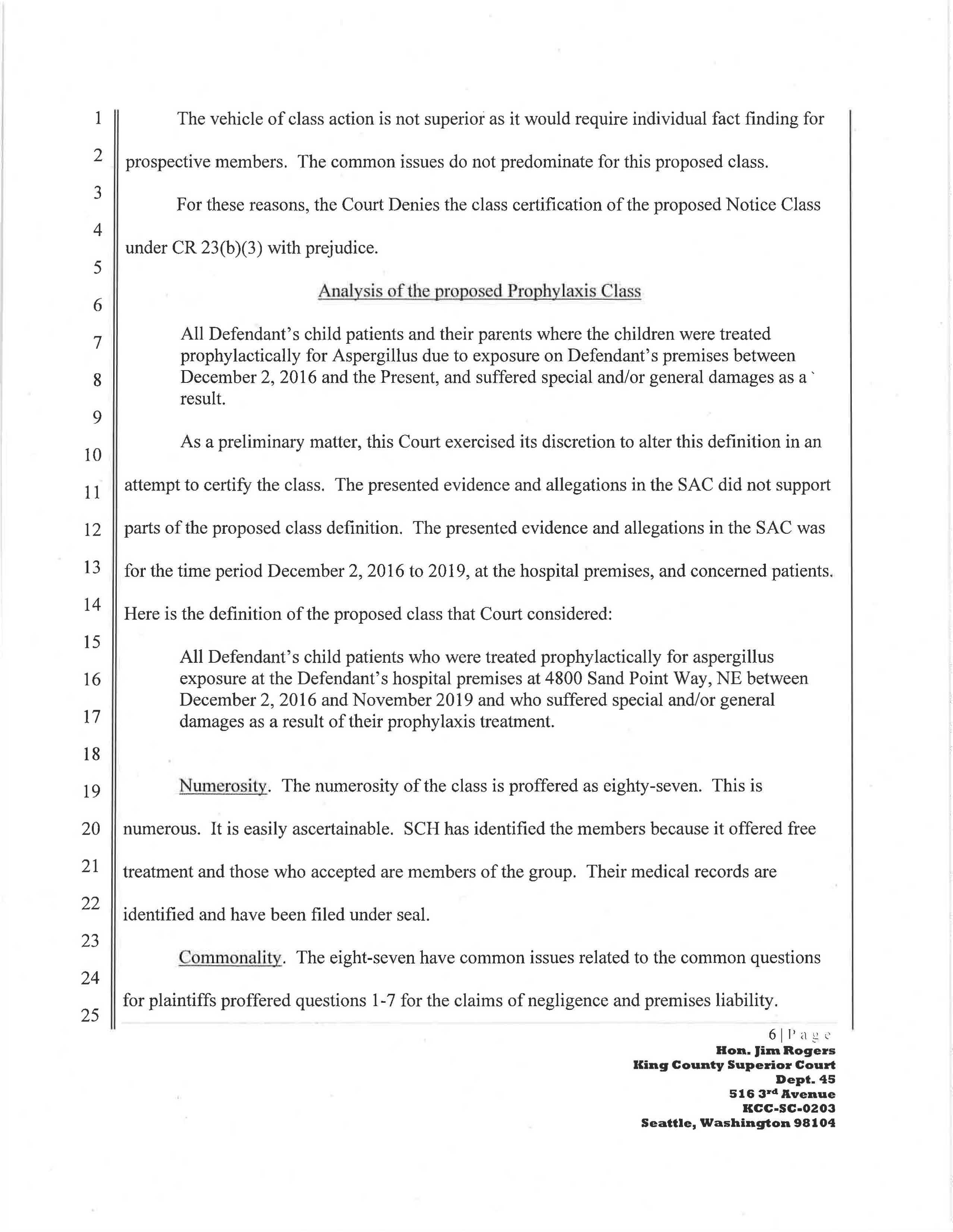
All Defendant's child patients who were treated prophylactically for aspergillus exposure at the Defendant's hospital premises at 4800 Sand Point Way, NE between December 2, 2016 and November 2019 and who suffered special and/or general damages as a result of their prophylaxis treatment.
Numerosity. The numerosity of the class is proffered as eighty-seven. This is numerous. It is easily ascertainable. SCH has identified the members because it offered free treatment and those who accepted are members of the group. Their medical records are identified and have been filed under seal.
Commonality. The eight-seven have common issues related to the common questions for plaintiffs proffered questions 1- 7 for the claims of negligence and premises liability. 6 I 1' a !_.! ,'
Hon. Jim Rogers
King County Superior Court Dept. 45 516 3~4 Avenue KCC-SC-0203 Seattle, Washington 98104
Plaintiffs Motion for Class Certification at p. 15. According to the factual materials, SCH offered a group of certain patients treatment for potential exposure and they accepted. SCH determined the fact of potential exposure.
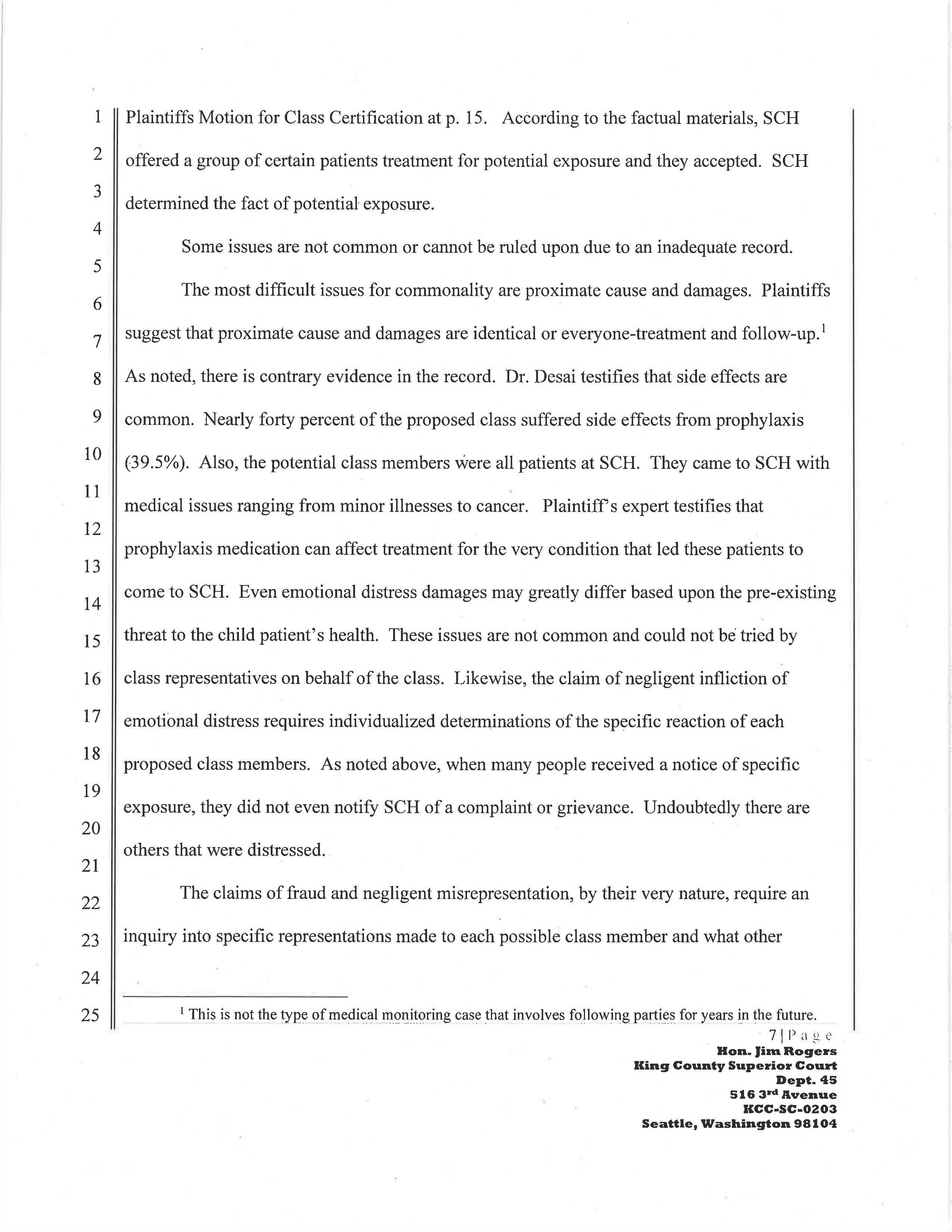
Some issues are not common or cannot be ruled upon due to an inadequate record. The most difficult issues for commonality are proximate cause and damages. Plaintiffs suggest that proximate cause and damages are identical or everyone-treatment and follow-up. 1 As noted, there is contrary evidence in the record. Dr. Desai testifies that side effects are common. Nearly forty percent of the proposed class suffered side effects from prophylaxis (39.5%). Also, the potential class members were all patients at SCH. They came to SCH with medical issues ranging from minor illnesses to cancer. Plaintiffs expert testifies that prophylaxis medication can affect treatment for the very condition that led these patients to come to SCH. Even emotional distress damages may greatly differ based upon the pre-existing threat to the child patient's health. These issues are not common and could not be tried by class representatives on behalf of the class. Likewise, the claim of negligent infliction of emotional distress requires individualized determinations of the specific reaction of each proposed class members. As noted above, when many people received a notice of specific exposure, they did not even notify SCH of a complaint or grievance. Undoubtedly there are others that were distressed. The claims of fraud and negligent misrepresentation, by their very nature, require an inquiry into specific representations made to each possible class member and what other 1 This is not the type of medical monitoring case that involves following parties for years in the future.
7 I P ,1 e
Hon. Jim Rogers
King County Superior Court Dept. 45 516 3wd Avenue KCC-SC-0203 Seattle, Washington 98104
information a party had at the time. Moreover, this class is defined as those treated by SCH for infection, and so it is not clear from the pleadings or briefing whether these claims were intended to be pled for this proposed class.
A hospital has a duty of informed consent under limited and extraordinary circumstances and this was not specifically briefed or addressed as to common questions. See Howell v. Spokane & Inland Empire Blood Bank. The question of what the hospital knew at the time of any specific patient over the time alleged may or may not be common as to each patient. Unlike questions 1- 7, the question of informed consent requires evidence that the hospital knew of a material risk at the time for each patient. There is insufficient information about this in the SAC or the declarations. On this record, it is not possible to rule upon commonality. The Motion is Denied as to this claim.
CR 23(a)(3)-(4) Adequacy and Typicality.
L.K., T;H., V.A., and C.F. are proposed class representafo:es. SCH opposes certain of these members as proposed class representatives
C.F. is not part of the class as he took antifungals for other reasons unrelated to the common questions here. Plaintiffs do not dispute this. C.F. is not adequate or typical. Plaintiffs argue that V.A. did not receive prophlaxis.at all and so would not be a member of the class. Plaintiffs submit Exhibit 14 to the Koehler Deel but it is not clear that this is for V.A. This inadequately redacted document was filed without the unredacted portion as the law requires, and the document blacks out the name of the patient in one place but also states "Nora remains symptom free." Is this a different patient? Plaintiffs did not file the 8 I 1>" g ('
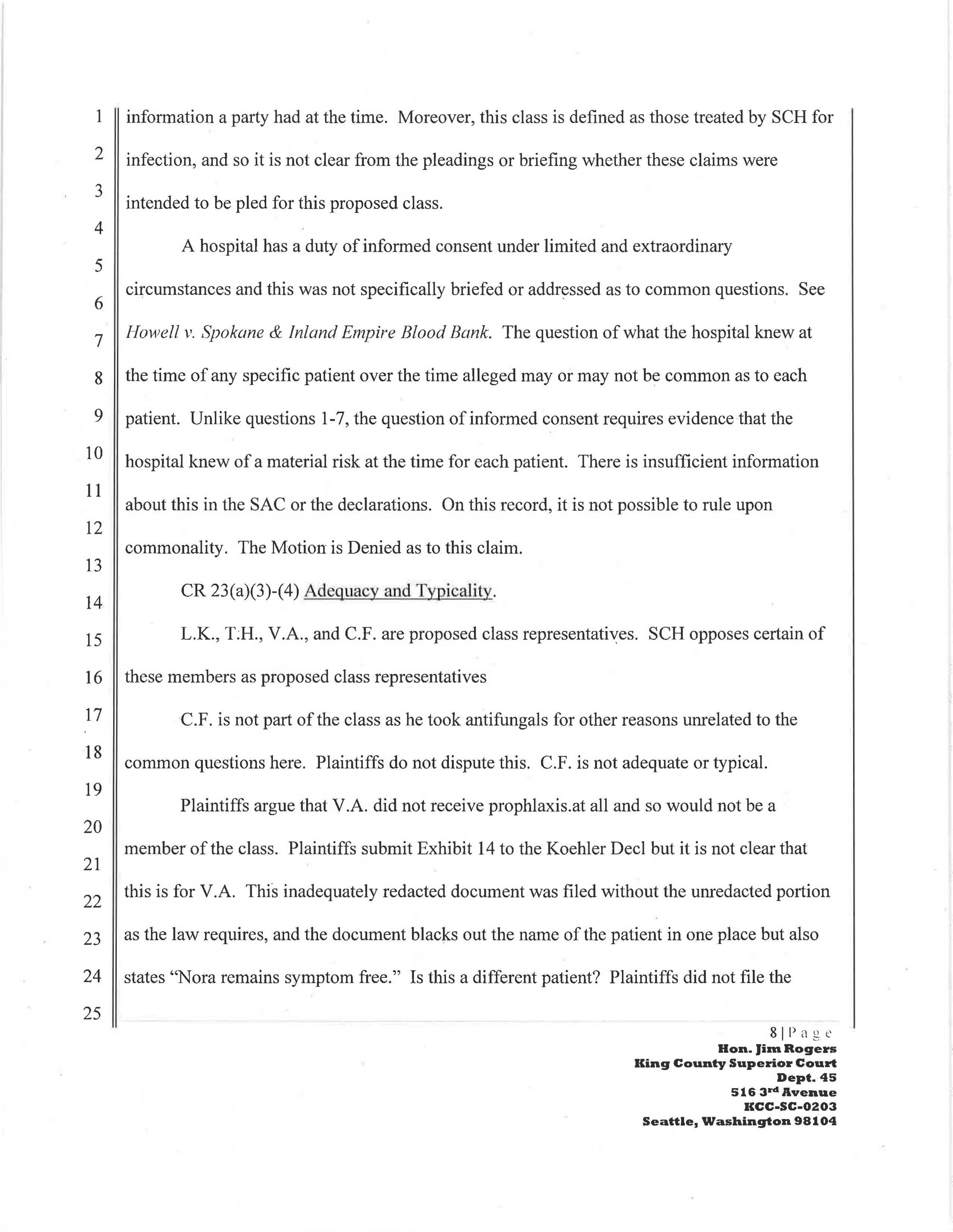
Hon. Jim Rogers
King County Superior Court Dept. 45 S 16 3 rd Avenue KCC-SC-0203 Seattle, Washington 98104
original under seal, it cannot be seen, and there is no corresponding identifier by initial under seal in Docket 502. Plaintiffs are ordered to file the original to Exhibit 14 under seal for final determination on this matter.
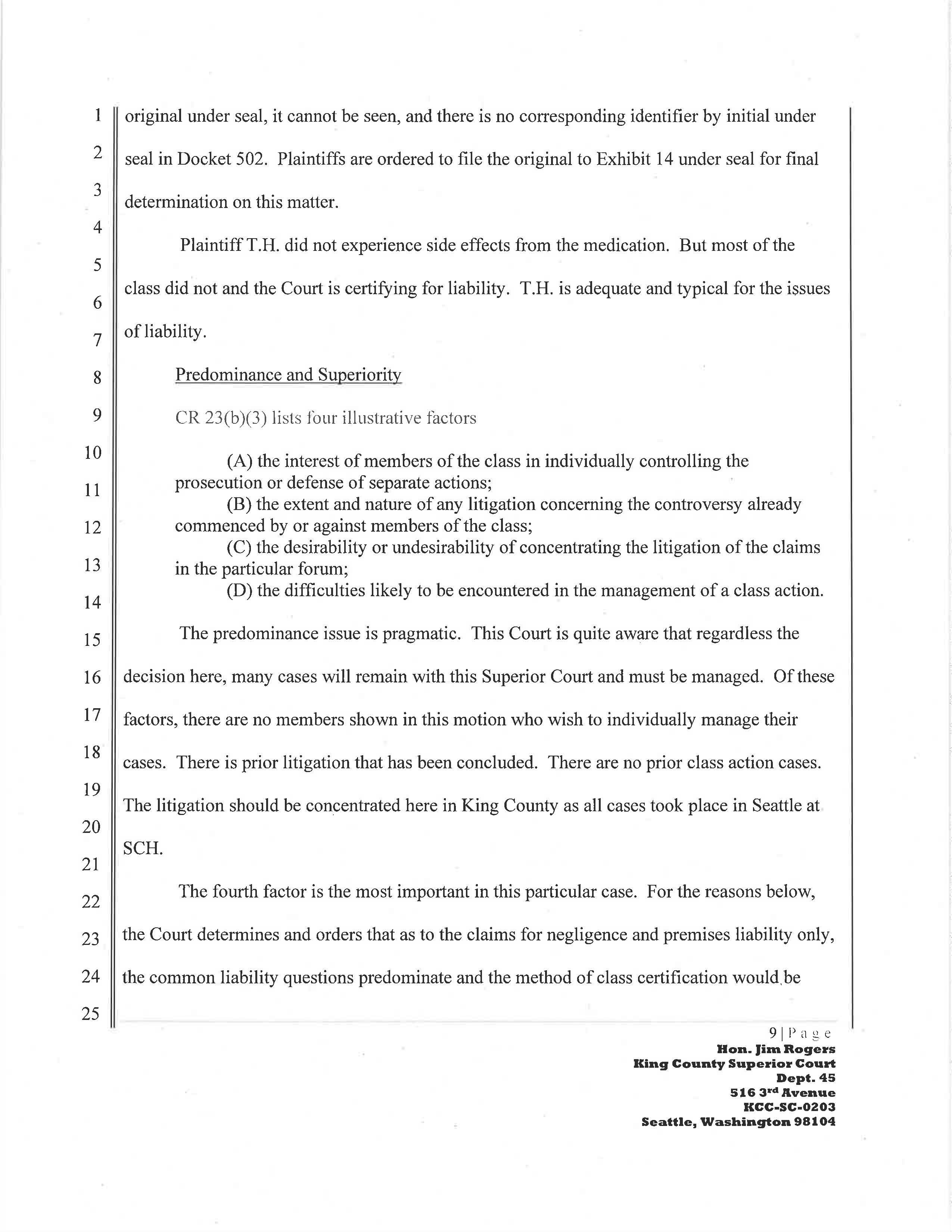
Plaintiff T.H. did not experience side effects from the medication. But most of the class did not and the Court is certifying for liability. T.H. is adequate and typical for the issues of liability.
Predominance and Superiority
CR 23(b)(3) lists four illustrative factors
(A) the interest of members of the class in individually controlling the prosecution or defense of separate actions;
(B) the extent and nature of any litigation concerning the controversy already commenced by or against members of the class;
(C) the desirability or undesirability of concentrating the litigation of the claims in the particular forum;
(D) the difficulties likely to be encountered in the management of a class action. The predominance issue is pragmatic. This Court is quite aware that regardless the decision here, many cases will remain with this Superior Court and must be managed. Of these factors, there are no members shown in this motion who wish to individually manage their cases. There is prior litigation that has been concluded. There are no prior class action cases. The litigation should be concentrated here in King County as all cases took place in Seattle at SCH.
The fourth factor is the most important in this particular case. For the reasons below, the Court determines and orders that as to the claims for negligence and premises liability only, the common liability questions predominate and the method of class certification would.be
Hon. Jim Rogers
King County Superior Court Dept. 45 5163 rd Avenue KCC-SC-0203 Seattle, Washington 98104
superior. The difficulties for managing the liability phase of the prophylaxis patients are small. They would not be difficult to manage, with appropriate class representatives. These are alleged exposures for a limited period and involve a common set of facts. Thus, the class action for this limited purpose is sufficiently cohesive to warrant adjudication by representation. See Amchem , 521 U.S. at 620.
As to claims of informed consent , fraud, negligent misrepresentation, and negligent infliction of emotional distress and as to proximate cause and damages , these issues do not predominate and a class action is not superior for the reasons discussed. 2 Plaintiffs appear to argue that once a court finds common facts for a class issue, such as liability here, the class should be certified for all purposes. They argue that Smith v. Behr stands for the proposition that once certified over common facts for liability, individual damages do not preclude certification for all purposes. That case was unusual procedurally and factually. In Smith, the class was "all persons and entities who purchased defendant's Products "Super Liquid Raw-Hide" or "Natural Seal Plus" and applied said Products to a natural wood exteriors .. . ' ' The damages were those to the plaintiffs' exteriors. The case was an unusual one, where the defense was defaulted on liability and the judge also constrained the parties on evidence and what damages were to be considered. 113 Wn.App . at 333-334. In any case, it would be hard to imagine the same procedural posture in this case or in a personal injury class action, where the individual damages determination is about wood surfaces versus child patients.
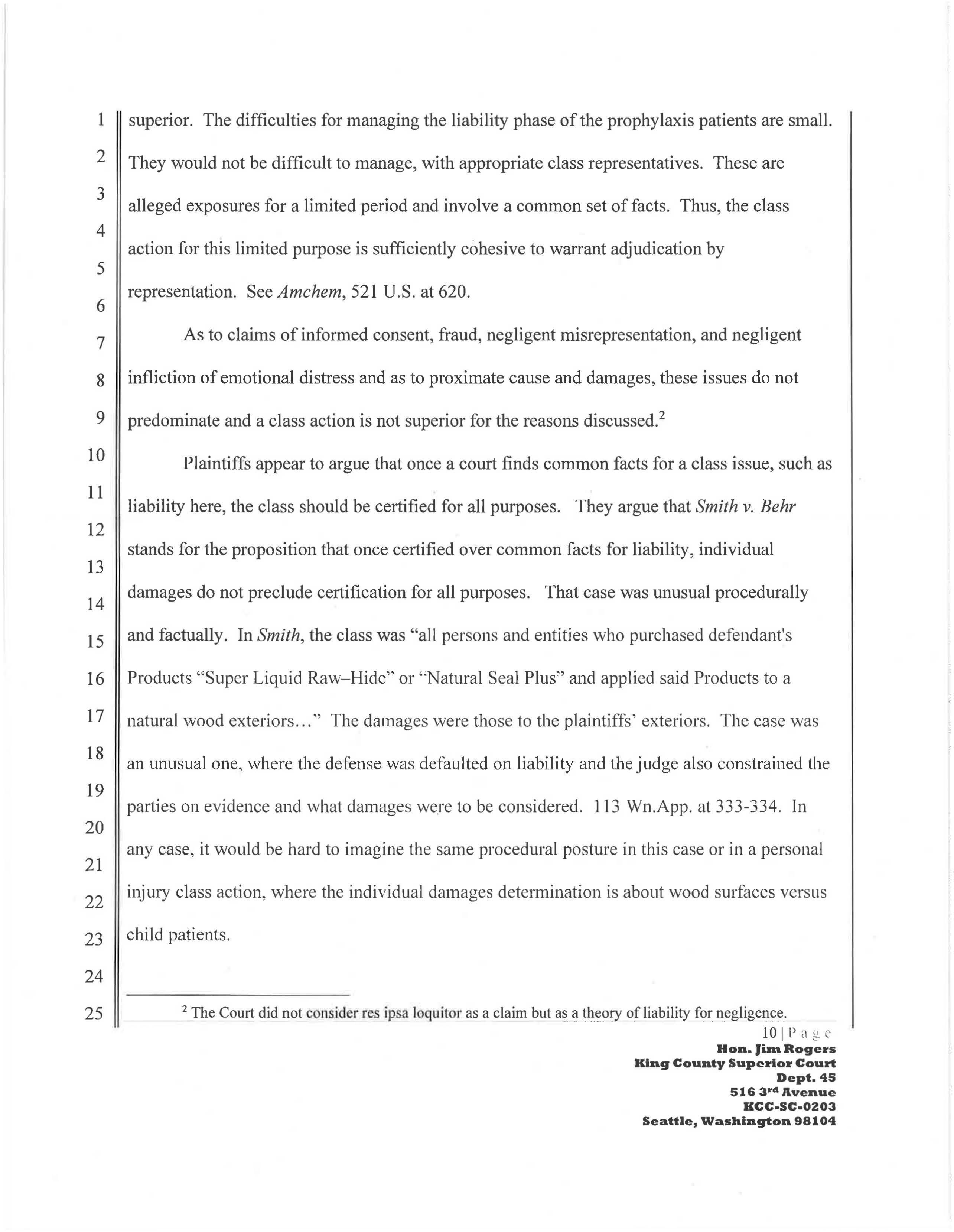
2 The Court did not consider res ip sa loquitor as a claim but a~ a th~ory of liability for negligence.
IOIP a gcHon. Jim Rogers
King County Superior Court Dept. 45 516 3 rd Avenue KCC-SC-0203 Seattle, Washington 98104
Plaintiffs also cite to other cases for the proposition that toxic exposure cases '·1·outinely get class treatment." Plaintiffs' Reply, p.5. The first case they cite, Peterson v. Costco, follows the approach taken in this Order. In that case, the Court ordered "[t]hus, "[ s]ince Plaintiff has established that, with the exception of determining damages, all of the required elements of class certification have been met the Court will exercise its discretion pursuant to Rule 23(c)(4) of the Federal Rules of Civil Procedures to certify the proposed class solel)' for purposes of determining liability." Lil~ v . •,08 F.R .D . a l '.244 .'' 312 F.R.D. at 584 [emphasis added]. When many trial courts state that individual damages issues cannot defeat certification, these courts sometimes mean that individual damages issues do not defeat a more limited ce1iification. 3 Plaintiffs also suggest that once a class is certified, the Court could create subclasses to address management. This the Court spent a great deal of time considering. To this question, Plaintiffs do not offer concrete suggestions, but this is by no means a criticism, because this question is a very, very difficult one, especially where possible class members have varying 3 The Court considered the many other cases decisions submitted. These cases illustrated the point that courts that have reached very different conclusions on cettification based upon the facts and practicalities. In Floyd v. Philadelphia, 8 PaD.&C.3d 3 80 (1978), the court noted that mass accident cases are normally not appropriate for class action due to a lack of common questions on damages and liability, but certified a class involving a chlorine gas release that injured people. That Court emphasized practical considerations (predominance) for liability and certain class members for damages and noted that sometimes certifying liability and severing it from damages could be appropriate. .
In Doe v. University Healthcare Systems, LLC, 145 So.3d 557, 569 (2014), the court declined certification of a class alleging contamination from endoscopic medivators because plaintiffs' medical history and mental health history were not common and did not predominate. Id at 579-80. Here, the damages issues are the variety of different health histories, underlying medical conditions and evidence of different side effects.
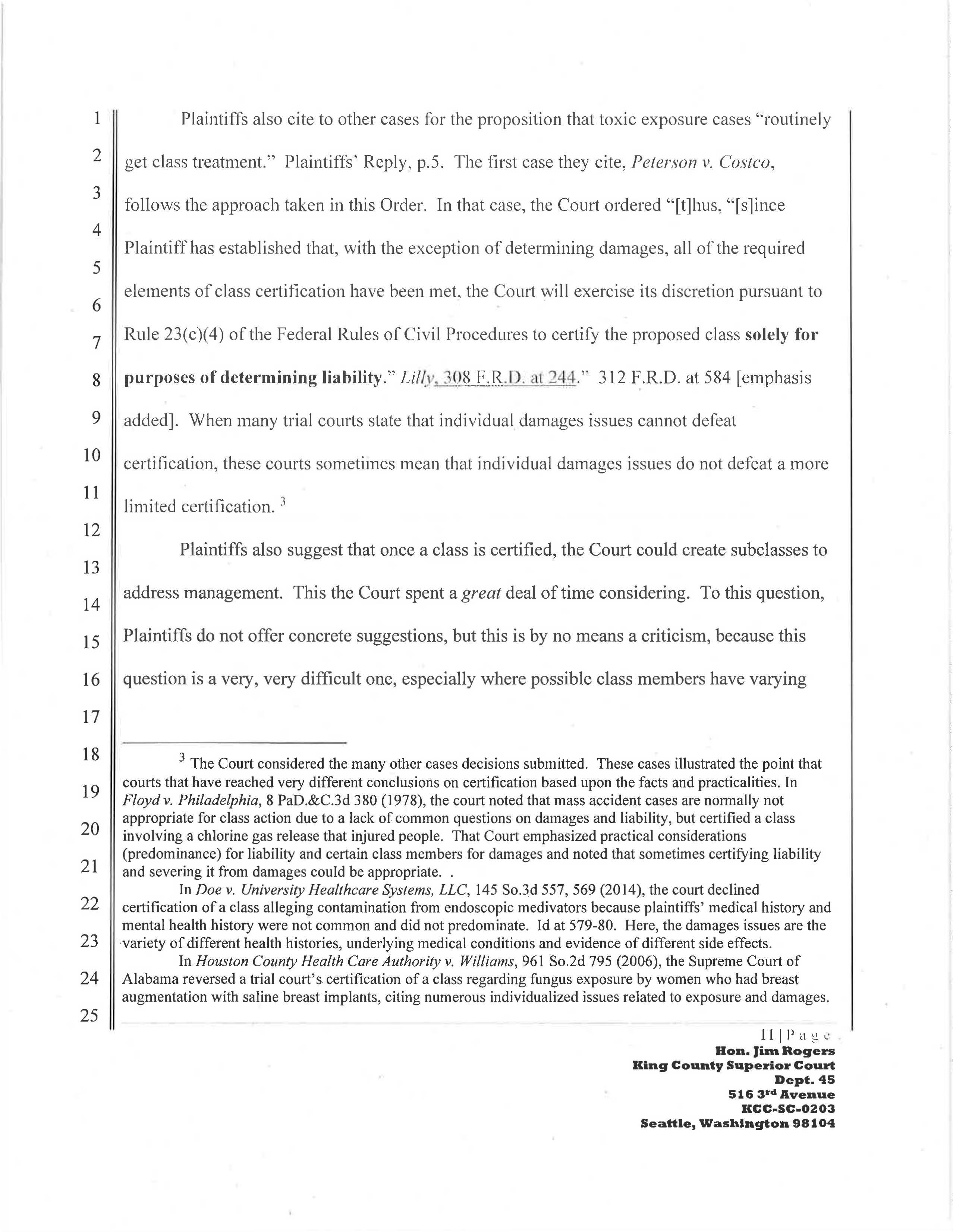
In Houston County Health Care Authority v. Williams, 961 So.2d 795 (2006), the Supreme Court of Alabama reversed a trial court's certification of a class regarding fungus exposure by women who had breast augmentation with saline breast implants, citing numerous individualized issues related to exposure and damages.
lllPa~c'.
Hon. Jim Rogers
King County Superior Court Dept. 45 516 3 rd Avenue
KCC-SC-0203 Seattle, Washington 98104
illnesses or injuries to begin with. In Admasu v. Port of Seattle, 185 Wn.App 23, the trial court struggled over exactly this question, finding that the valuation methodology had not been considered by the economists and thus there was not evidence to find common issues on damages. Id at 33.
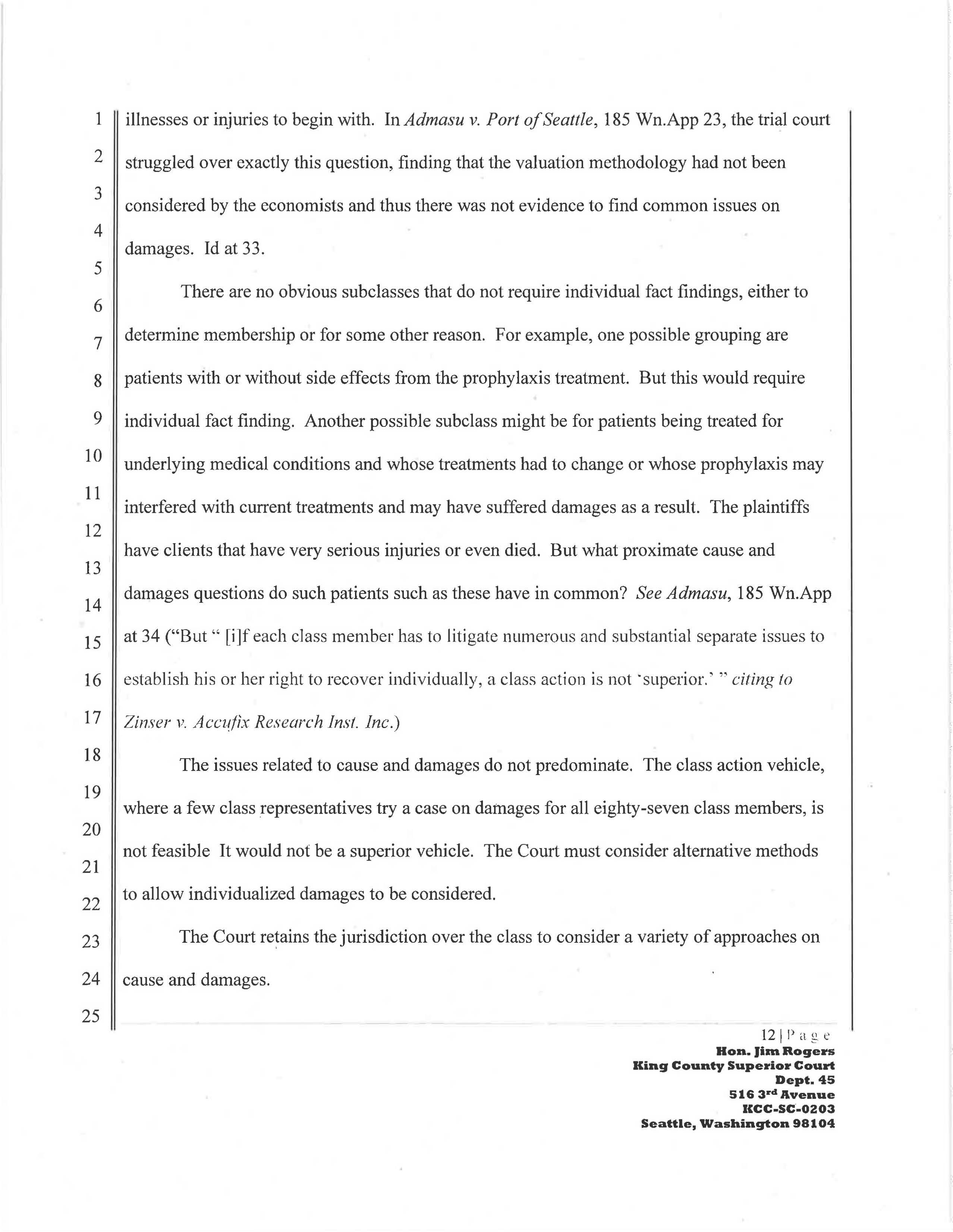
There are no obvious subclasses that do not require individual fact findings, either to determine membership or for some other reason. For example, one possible grouping are patients with or without side effects from the prophylaxis treatment. But this would require individual fact finding. Another possible subclass might be for patients being treated for underlying medical conditions and whose treatments had to change or whose prophylaxis may interfered with current treatments and may have suffered damages as a result. The plaintiffs have clients that have very serious injuries or even died. But what proximate cause and damages questions do such patients such as these have in common? See Admasu, 185 Wn.App at 34 ("But" [i]f each class member has to litigate numerous and substantial separate issues to establish his or her right to recover individually, a class action is not ·superior.' "citinK to Zinser v. Accufix Research Inst. Inc.)
The issues related to cause and damages do not predominate. The class action vehicle, where a few class representatives try a case on damages for all eighty-seven class members, is not feasible It would not be a superior vehicle. The Court must consider alternative methods to allow individualized damages to be considered. The Court retains the jurisdiction over the class to consider a variety of approaches on cause and damages.
Closing Comments
This Court has been guided by the pragmatic approach of CR 23(b)(3). In McLaughlin on Class Actions, sec. 5.6, the author, in discussing superiority, states "Winston Churchill suggested that democracy should be judged, not against some ideal, but in relation to its alternatives, which have been tried from time to time." As the author goes on to note, the principles of deciding whether the class action vehicle is superior requires considerations of fairness and comparison with alternative means of adjudication. These led the Court to certify for a limited purpose. These principles that will guide the Court in the future to manage and create a plan for the litigants in all phases, working with the parties and the Special Master, in 2023.
IT IS SO ORDERED:
The Motion to certify the Notice Class is Denied with Prejudice. The Motion to certify the Prophylaxis Class is Granted and Denied as follows: The following Prophylaxis Class: All Defendant's child patients who were treated prophylactically for aspergillus exposure at the Defendant's hospital premises at 4800 Sand Point Way, NE between December 2, 2016 and November 2019 and who suffered special and/or general damages as a result of their prophylaxis treatment. 23 Is Certified as to liability issues on the following claims: medical negligence and 24 premises liability only;

Hon. Jim Rogers
King County Superior Court Dept. 45 516 3 rd Avenue KCC-SC-0203 Seattle, Washington 98104
The trial on the Class issues of liability is bifurcated from the issues of cause and damages as to all prophylaxis class members;
Certification is Denied as to all other claims and issues, however, as with any certified class, this Court retains the authority to flexibly manage all issues related to the Prophylaxis Class specifically as to proximate cause and damages as to the two certified claims.
The Court will not consider further classes for certification.
The parties shall schedule a pretrial conference for the creation of a reasonable plan for trial on liability and the remaining issues of cause and damages in 2023. The Special Master will be involved.
Plaintiffs shall prepare a proposed order listing all pleadings filed for this motion.
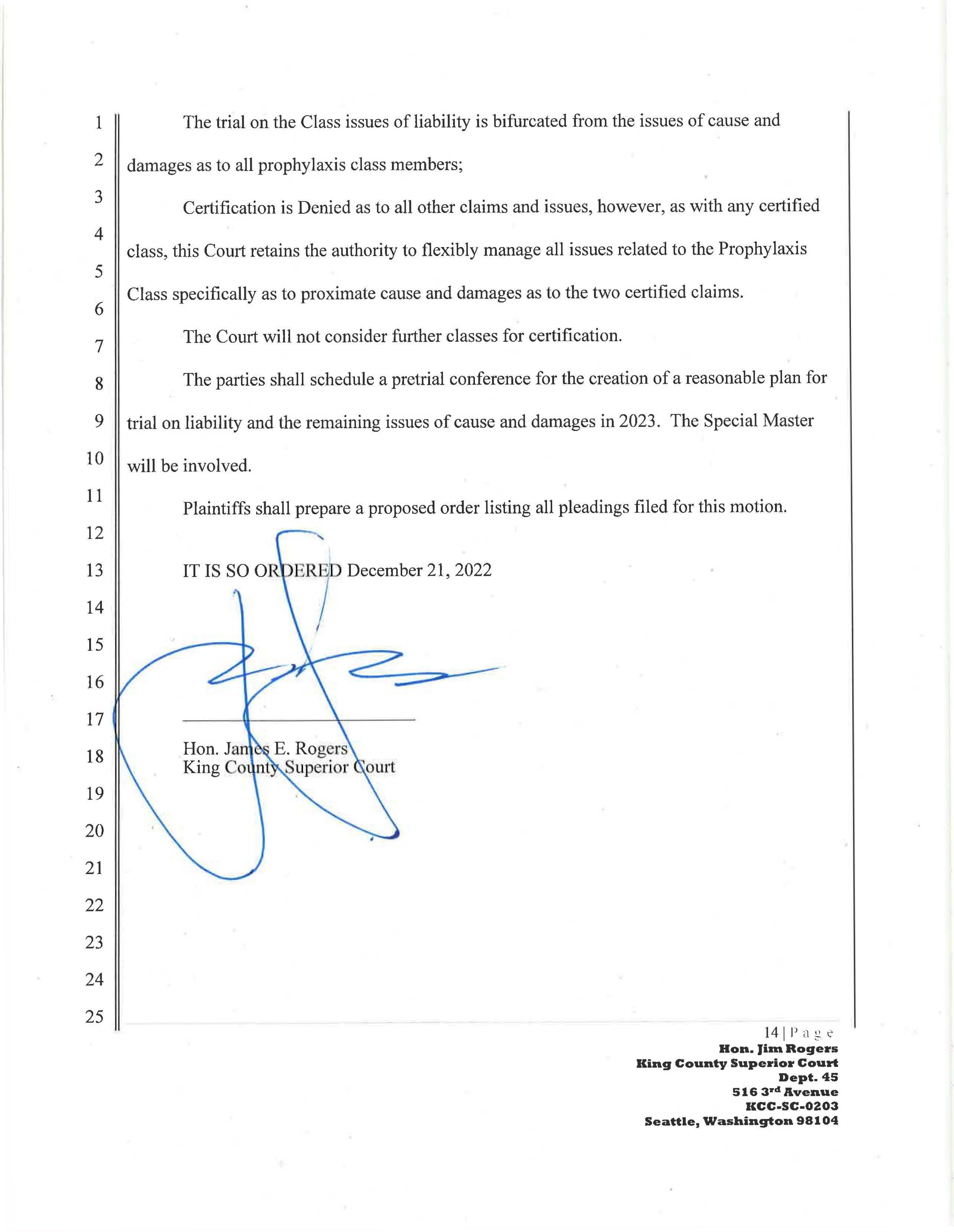
14 I P ,1~e
Hon. Jim Rogers
King County Superior Court Dept. 45 516 3 rd Avenue KCC-SC-0203 Seattle, Washington 98104
